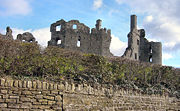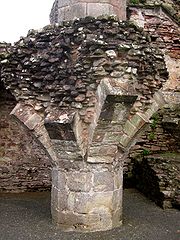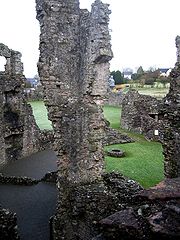
Coity Castle
Encyclopedia

Norman architecture
About|Romanesque architecture, primarily English|other buildings in Normandy|Architecture of Normandy.File:Durham Cathedral. Nave by James Valentine c.1890.jpg|thumb|200px|The nave of Durham Cathedral demonstrates the characteristic round arched style, though use of shallow pointed arches above the...
castle
Castle
A castle is a type of fortified structure built in Europe and the Middle East during the Middle Ages by European nobility. Scholars debate the scope of the word castle, but usually consider it to be the private fortified residence of a lord or noble...
built by Sir Payn "the Demon" de Turberville (fl.1126), one of the legendary Twelve Knights of Glamorgan
Twelve Knights of Glamorgan
Twelve Knights of Glamorgan were the legendary followers of Robert FitzHamon, the Norman conqueror of Glamorgan. They are figures in early Welsh history....
supposed to have conquered Glamorgan under the leadership of Robert FitzHamon
Robert Fitzhamon
Robert Fitzhamon , or Robert FitzHamon, Sieur de Creully in the Calvados region and Torigny in the Manche region of Normandy, was Lord of Gloucester and the Norman conqueror of Glamorgan, southern Wales...
(d.1107), Lord of Gloucester. Now in ruins, it stands in the Community of Coity Higher near the town of Bridgend
Bridgend
Bridgend is a town in the Bridgend County Borough in Wales, west of the capital, Cardiff. The river crossed by the original bridge, which gave the town its name, is the River Ogmore but the River Ewenny also passes to the south of the town...
, in the County Borough
County borough
County borough is a term introduced in 1889 in the United Kingdom of Great Britain and Ireland , to refer to a borough or a city independent of county council control. They were abolished by the Local Government Act 1972 in England and Wales, but continue in use for lieutenancy and shrievalty in...
of Bridgend
Bridgend (county borough)
Bridgend is a county borough in the historic county of Glamorgan, south Wales. The county borough has a total population of 130,000 people, and contains the settlements of Bridgend, after which it is named, Maesteg, and the seaside town of Porthcawl...
. Very close to the castle is the battlement
Battlement
A battlement in defensive architecture, such as that of city walls or castles, comprises a parapet , in which portions have been cut out at intervals to allow the discharge of arrows or other missiles. These cut-out portions form crenels...
ed parish church of St Mary the Virgin, dating from the 14th century.
Castle Construction and Modification
The castle began as a late 11th century ringworkRingwork
A ringwork is a form of fortified defensive structure, usually circular or oval in shape. Ringworks are essentially motte-and-bailey castles minus the motte...
. A rectangular stone keep
Keep
A keep is a type of fortified tower built within castles during the Middle Ages by European nobility. Scholars have debated the scope of the word keep, but usually consider it to refer to large towers in castles that were fortified residences, used as a refuge of last resort should the rest of the...
and the main curtain wall
Curtain wall (fortification)
A curtain wall is a defensive wall between two bastions of a castle or fortress.In earlier designs of castle the curtain walls were often built to a considerable height and were fronted by a ditch or moat to make assault difficult....
were added by the Normans in the 12th century, under the de Turberville family. The three-storey keep was primarily a defensive structure.

Gatehouse
A gatehouse, in architectural terminology, is a building enclosing or accompanying a gateway for a castle, manor house, fort, town or similar buildings of importance.-History:...
. New stone vaults replaced the earlier timber floors. The central octagonal pier for the vaults is still prominent among the castle ruins. An adjoining chapel wing with a tall east window was added to the first floor at the eastern end of the domestic range in the 15th century.

Undercroft
An undercroft is traditionally a cellar or storage room, often brick-lined and vaulted, and used for storage in buildings since medieval times. In modern usage, an undercroft is generally a ground area which is relatively open to the sides, but covered by the building above.- History :While some...
, from which it was reached by a grand spiral stair. To the west were ground-floor service rooms, probably including a kitchen, with ovens. The base of a ruined large malt
Malt
Malt is germinated cereal grains that have been dried in a process known as "malting". The grains are made to germinate by soaking in water, and are then halted from germinating further by drying with hot air...
ing kiln remains. On the far side of the range, a tower projecting from the curtain wall contained latrine
Latrine
A latrine is a communal facility containing one or more commonly many toilets which may be simple pit toilets or in the case of the United States Armed Forces any toilet including modern flush toilets...
s. The second floor housed private apartments.
The Lordship of Coity
Turberville
The de Turberville family held the Lordship of Coity from c. 1092 to 1360, which had been founded by Sir Payn de Turberville, one of the legendary Twelve Knights of GlamorganTwelve Knights of Glamorgan
Twelve Knights of Glamorgan were the legendary followers of Robert FitzHamon, the Norman conqueror of Glamorgan. They are figures in early Welsh history....
of Robert FitzHamon
Robert Fitzhamon
Robert Fitzhamon , or Robert FitzHamon, Sieur de Creully in the Calvados region and Torigny in the Manche region of Normandy, was Lord of Gloucester and the Norman conqueror of Glamorgan, southern Wales...
, 1st. Lord of Glamorgan
Lord of Glamorgan
The Lordship of Glamorgan was one of the most powerful and wealthy of the Welsh Marcher Lordships. Established by the conquest of Glamorgan from its last Welsh ruler the Anglo-Norman lord of Glamorgan like all Marcher lords ruled his lands directly by his own law, thus they could amongst other...
. Richard de Turberville, seemingly his 6th great grandson, died in 1384 without male heir, leaving his four sisters as co-heiresses. Katherine the eldest had married Sir Roger Berkerolles (d.1351), another descendant of one of the Twelve Knights of Glamorgan
Twelve Knights of Glamorgan
Twelve Knights of Glamorgan were the legendary followers of Robert FitzHamon, the Norman conqueror of Glamorgan. They are figures in early Welsh history....
, of East Orchard, St. Athan's. The tomb effigies of Katherine and Sir Roger can be seen in St. Athan's Church. Margaret the second daughter had married Sir Richard Stackpole, whose daughter Joan married Sir Richard Verney. The third daughter was Agnes who had married Sir John de la Bere of Weobly Castle, Gower. Sarah the fourth and youngest had married William Gamage of Rogiet.
Berkerolles
It was Sir Lawrence Berkerolles (d.1411), son of Katherine the eldest daughter, who succeeded to Coity. His sister Wenllian Berkerolles had married Sir Edward Stradling of nearby St. Donat's Castle. Under his tenure Coity Castle resisted an attack by the forces of Owain GlyndŵrOwain Glyndwr
Owain Glyndŵr , or Owain Glyn Dŵr, anglicised by William Shakespeare as Owen Glendower , was a Welsh ruler and the last native Welshman to hold the title Prince of Wales...
(Owen Glendower) and a long siege followed lasting into 1405. King Henry IV
Henry IV of England
Henry IV was King of England and Lord of Ireland . He was the ninth King of England of the House of Plantagenet and also asserted his grandfather's claim to the title King of France. He was born at Bolingbroke Castle in Lincolnshire, hence his other name, Henry Bolingbroke...
was petitioned by Parliament to send a relief force and he dispatched three Bristol sea captains to resupply the besieged garrison. The Berkerolles' tenure of Coiety ended on October 18, 1411, on the death of Sir Lawrence sine prole.
De la Bere
The heir of Sir Lawrence Berkerolles was his 1st. cousin once removed, the minor Thomas de la Bere, the son of John de la Bere deceased, son of Agnes Turberville (3rd. sister of Richard) and Sir John de la Bere. Margaret de Turberville the 2nd. sister appears to have produced no male progeny, only a daughter, Johanna, Lady Vernon. During the minority of Thomas, Coity briefly escheated to the King, under the hand Isabel Despenser, seemingly in her capacity as Lord of Glamorgan, she being the wife of Richard de Beauchamp, Lord of Bergavenny,Gamage
Thomas de la Bere died as a minor on 28 October 1414, following which the lordship reverted to Sarah de Turberville, the youngest sister of Richard de Turberville, who had apparently produced male progeny from her marriage to William Gamage. There was in the few years following Sir Lawrence Berkerolles's death much general re-shuffling of property interests in Glamorgan, for example with the Stradling family. Sarah's marriage to Sir William Gamage of Roggiett, GwentGwent (county)
Gwent is a preserved county and a former local government county in south-east Wales. It was formed on 1 April 1974, under the Local Government Act 1972, and was named after the ancient Kingdom of Gwent....
brought the lordship into the Gamage family, where it remained until 1584. The Gamage succession was not however easily achieved for in September 1412, that is to say whilst the supposed true heir the minor Thomas de la Bere was still alive, William Gamage assisted by Sir Gilbert Denys(d.1422) of Siston
Siston
Siston is a small village in South Gloucestershire, England east of Bristol Castle, ancient centre of Bristol, recorded historically as Syston, Sistone, Syton, Sytone and Systun etc. The village lies at the confluence of the two sources of the Siston Brook, a tributary of the River Avon...
, Gloucestershire and formerly of Waterton-by-Ewenny, in Coity lordship, besieged Coity for a month, trying to oust Lady Joan Verney, wife of Sir Richard Verney and daughter of Margaret de Turberville, from the Castle. Joan it seems had taken up residence to assert her own claim to Coity in the confusion following Berkerolles's death. As she was a female, a widower and without a son, clearly her claim was deemed tenuous or rather completely spurious. The entry in the Patent Rolls is as follows:
Westminster Sept. 16, 1412.
Commission to William Newport, Chivaler, Rees ap Thomas, John Organ, William Sparenore, Richard Delabere and Robert Wytney on information that Gilbert Denys, Chivaler, and William Gamedge, with no moderate multitude of armed men have gone to the castle of Coytif in Wales and besiege it and purpose to expel Joan, late the wife of Richard Vernon, Chivaler, from her possession of it, to go as quietly as they can to the castle and raise the siege, cause proclamation to be made that no one under pain of forfeiture shall besiege it, but those who pretend right and title in it shall sue according to law and custom. Arrest amd imprison all who oppose them and certify thereon to the King in Chancery. By K.
The king had therefore given a commission to his local tenants-in-chief to raise the siege and gave another commission a month later to John Grendour for the same purpose. Denys and Gamage ended up in the Tower of London for having taken the law into their own hands, from 19th. November 1412 until 3rd. June 1413, being released after the death of Henry IV. Their action however proved successful in enforcing the Gamage claim to Coity. Denys's eldest daughter Joan was the wife of a certain Thomas Gamage, possibly brother of William. Another of Denys's daughters, Matilda, by his 2nd. wife, married another Thomas Gamage, son or grandson of William and Sarah, and thereby became Lady of Coity on her husband's succession, producing a son & heir John Gamage.
Sidney
The Gamage family held Coity until the death of John Gamage in 1584. His sole heiress Barbara GamageBarbara Gamage
Barbara Sidney, Countess of Leicester was a Welsh heiress, and the first wife of Robert Sidney, 1st Earl of Leicester.Barbara Gamage inherited Coity Castle, Glamorgan, on the death of her father, John Gamage, in 1584, and became the ward of Sir Edward Stradling of St Donat's Castle, Glamorgan,...
had married Robert Sidney, 1st Earl of Leicester
Robert Sidney, 1st Earl of Leicester
Robert Sidney, 1st Earl of Leicester , second son of Sir Henry Sidney, was a statesman of Elizabethan and Jacobean England. He was also a patron of the arts and an interesting poet...
and thus Coity passed to the Sidney family, whose chief seat was Penshurst Place
Penshurst Place
Penshurst Place is a historic building near Tonbridge, Kent, south east of London, England. It is the ancestral home of the Sidney family, and was the birthplace of the great Elizabethan poet, courtier and soldier, Sir Philip Sidney. The original medieval house is one of the most complete examples...
in Kent, which held it until the 18th. century. Barbara died at Coity in 1621.
Edwin & Earls of Dunraven
The lordship was sold in the 18th. c. to the Edwins of Llanfihangel. Through the Edwins, the Coity lordship passed to the Earls of DunravenEarl of Dunraven and Mount-Earl
Earl of Dunraven and Mount-Earl was a title in the Peerage of Ireland. It was created on 5 February 1822 for Valentine Quin, 1st Viscount Mount-Earl. Quin was created a Baronet, of Adare in County Limerick, in the Baronetage of Ireland, in 1781, Baron Adare in 1800 and Viscount Mount-Earl in 1816...
.
Decline
The castle was abandoned around the 17th century and the castle ruins are now in the care of CadwCadw
-Conservation and Protection:Many of Wales's great castles and other monuments, such as bishop's palaces, historic houses, and ruined abbeys, are now in Cadw's care. Cadw does not own them but is responsible for their upkeep and for making them accessible to the public...
.

